"I Loved Martyrdom, Which so Strangely Cleanses the Soul"*
* This is a talk given by Archimandrite Father Nektarios Antonopoulos regarding the wondrous and martyric life of St. Luke, Archbishop of Simferopol and Crimea – a doctor, miraculous person and confessor of the faith. It is a strong and touching text, rich with photographs. The talk was presented along with a slideshow of photographs in our monastery's reception area on Tuesday, November 23, after the having received the relics St. Luke.
The life of this great saint has a lot to teach us about the life in Christ. Also, it is of great importance that through his life's vivid martyrdom, a resonant answer is given to two controversial views. First, his two positions – renown doctor and bishop – rejects the premise that science is in conflict with religion. Second, the unjust, cruel torture he suffered and the shameless disdain for this great scientist, his discoveries, his studies and progressive practices – to a point that he had been considered a "second category citizen" – unveil the atrocity of atheistic totalitarian regimes. St. Luke's life ought to be studied not only from a religious and medical point of view – as is already the case – but also socially, politically and historically. It can provide multiple answers to ignorance and propaganda.
***
If anybody finds themselves on Mount Athos or anywhere with other ancient churches, they will notice that many of the churches are painted red. And if one were to ask the monks, they would reply that this red color symbolizes Christ's blood, as well as that of His Saints'. It reminds people, that even though various religions or ideologies were spread through propaganda, violence and oppression, Christ's Church won over people's hearts through meekness, Christ's and His Saints' blood, torture and martyrdom. There is no Orthodox Church that did not pass through martyrdom. Neither has there been a saint who did not go through his personal furnace of sorrows, temptations and martyrdom.
During the twentieth century, the Russian church went through her own cruel martyrdom. For seven decades a countless multitude of martyrs and confessors went through their own personal "crucifixion," offering their own blood.
One such moving martyrdom is that of Archbishop Luke, professor of Topographic Anatomy and Surgery. This man with rare talents and gifts, who served people as a pastor and as a doctor, with admirable love and self-denial, continued the traditions of the great Holy Unmercenary Doctors of our Church. This incredible figure and his divine greatness is the cause of astonishment, admiration, and divine consolation.
In today's presentation, we will try to briefly draw near this individual, and make a diagram of his journey.
Before we do that, let us travel together to the holy land of Russia, to examine the physical, social and spiritual environment in which St. Luke lived. We find ourselves in the nineteenth century, a difficult and troubled era. The standards of living for the Russian people were very low. Their living conditions were repulsive. It was of no surprise that new nihilistic ideologies and theories found fertile ground, and gradually affected a large part of the Russian people.
During this difficult time, the role of counterbalancing the spiritual erosion of the Russian people was played by a number of Russian monasteries and great "starets (elders)." Let us first visit the monasteries of Sarov and Diveevo, where the figure of St. Seraphim of Sarov is prominent. A countless number of people went there, longing to see him. He received everyone with love, addressing them sweetly: "My joy, Christ is Risen."
Near the monastery in Sarov, a women's monastery was built in Diveevo, which the saint greatly helped. A little before he "fell asleep" he foresaw and forewarned about all the distressful things that were to follow. He said that there would be such great sorrow and so many martyrs, that the angels would not have time to collect all the souls.
However, he foresaw that 70 years later, the Church would again shine. In 1990, his relics and personal items were found in Petersburg and were brought to Diveevo. Today, 250 nuns live in Diveevo, who practice the sleepless prayer, just as of St. Seraphim directed.
Another renown monastery is Valaam, located on the evergreen islands of Lake Ladoga. Monastic life began there during the twelfth century. Initially, the central monastery was built and around it many sketes. It's a quiet and beautiful place.
Another very important one is the monastery of Optina, which played a catalytic role in Russia's spiritual life during the nineteenth century. Within 100 years, it unveiled 15 saints; they are the famous starets. Thousands of people went to them, including intellectuals and scientists of that era.
In Western Ukraine lies the Pochaev monastery, a blessed spot, where the Virgin Mary appeared and where her footprint remains on a rock. This monastery was a bulwark for the Orthodox and against the Uniates.
We now come to 1877. St. Luke was born on April 14, known in the world as Valentin Voino-Yasenetsky. His earthly motherland was Kerch, the ancient Greek-Pontian area in Crimea. During the ninth century in this area, the Greeks built the famous church of St. John the Baptist, one of Crimea's most important monuments. Today, St. Luke's bust also sits in front of the Church.
The saint's father was a pharmacist. However, the pharmacy was not doing well so he decided to leave it. He then worked as a civil servant. The saint's mother was Maria Kudrim, distinguished for her philanthropic works. Apart from St. Luke, the couple Voino-Yasenetsky had four other children, three boys and two girls in total.
Because the family's financial situation was worsening, the parents decided to move to Kiev, the cradle of Russian Christianity. It is a very beautiful and exceedingly green city, with the Dnieper River running through it. The first Christian prince, St. Vladimir, baptized his people in this river in the year 988, and established the Orthodox faith in the Russian land. The Voino-Yasenetsky family lived in a house in the city centre, on Kresatic Street. Young Valentin did not seem to be unique as a child. They all considered him average and said, "nobody can expect this child to do anything significant with his life." However, he did stand out due to his seriousness, honesty, morals, and sensitivity. From a very early age, he manifested his talent in art. While in secondary school, he also studied in Kiev's academy of fine arts. At the age of 15, he took part in an art contest and won first prize.
Within his soul two worlds were at constant battle, those of doubt and of faith. The key factor to affect his soul was the illustrious monastery of Pechersk Lavra – the Lavra of the Caves. The monastery lies on a very green 28 hectares (about 70 acres) within the city of Kiev, right on the Dnieper River. It has been home to thousands of monks and produced numerous saints. Other than the archeological value and interest which it has for visitors, the Lavra holds unique spiritual treasures. The ancient ascetics dug their cells underground and lived a confined life, practicing ceaseless prayer.
As the years passed by, two big intricate catacombs were created, and on each side of the pathways they built their cells. The confined ascetics filled in the doorway and left only a window. Everyday a monk would pass by and leave them some bread and water. They lived on that. When someone did not take this meager sustenance for 3 to 4 days, they knew that he had died. Then, the other monks would close up the window and the cell would become their grave. When, after years, these cells were opened, all the ascetics' relics were found incorrupt. It is a unique phenomenon in the world, one place consisting of 118 incorrupt holy relics.
There, in the catacombs, the skulls of other saints are kept that smell of myrrh. The skulls strangely become wet. Every now and then, the monks collect this myrrh and give it to the pilgrims. Pechersk Lavra is truly a blessed place. The entire life, motion and vivid monastic tradition, which had continued for centuries, had a decisive effect on young Valentin, who used to visit it and draw the pilgrims and monks.
During the same period, he was influenced by the ideas of the great Russian writer Tolstoi's, with whom he exchanged letters on a personal basis. However, he soon understood his errors in matters of faith and stopped communication. At the same time, he did not seize to diligently read the Holy Scriptures.
When he finished school, he was indecisive on what path he should take. Initially, he signed up at law school, but a year later he left it. After that, he left for Munich to study at the School of Fine Arts next to the famous professor Knir but soon returned to Kiev. Within him he had realized the intense interest in serving others, his fellow man. At this difficult turning point, he discussed his concerns with a professor, who encouraged him to study medicine. In this way, he would be able to render his assistance to the villagers who had poor medical care.
In year 1898, he began his studies at the Medical School of the University of Kiev, famous for its excellent educational level. Right from the start his interest turned towards anatomy.
He finished his studies with honors and a specialization in surgery. He immediately began operating, especially on ophthalmologic illnesses. At that time, trachoma was widespread, a terrible disease of the eyes and many people became blind. The young doctor implemented a difficult method, Cheiloplasty, and granted sight to thousands of people.
Before he had the time to work in rural areas, the Russian-Japanese War broke out and Valentin volunteered to serve with the Red Cross. Together with other doctors they took the train to the Far East. The trip lasted a month. They settled in the city of Chita and he, despite the fact that he was young, took up managing one of the surgical departments of the military hospital. He operated on the injured soldiers and performed operations from the simplest to the most difficult with incredible ease.
In Chita, he met Anna Vasilevna, a volunteer nurse, exemplary for her morals. They got married and had four children.
From 1905 to 1910 he worked in various provincial hospitals. The needs were great. He needed to be a surgeon and a gynecologist, a pathologist and a pediatrist, a hygienist and a dentist.
At that time he came across the problem of general anesthesia. It had just started to be applied, but because there were no anesthesiologists and the right means were missing, general anesthesia was more dangerous than the operation itself. That's why he attempted to find new ways of local anesthesia. Indeed soon enough, at 29 years old, he discovered a new method of local anesthesia in the sciatic nerve. He later presented this report as his dissertation and was approved with honors. Very often he would go up to Moscow to prepare his dissertation.
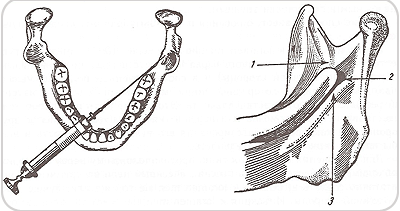
In 1910, he moved to the city of Pereslav Zalesky. He found himself in a pretty and scenic city, but working conditions were bad. The hospital was composed of 50 beds, but its operational equipment was primitive. There was neither electricity, nor an X-ray machine. Water was brought in daily by the water-seller in a barrel.
Every morning, a carriage would take him to the hospital. He took advantage of this time as well. During the journey, he read about methods in foreign languages and managed to learn seven languages. He performed surgical operations for long hours, while at nights he shut himself in his office, and under the dim light of a petrol lamp he continued his scientific studies.
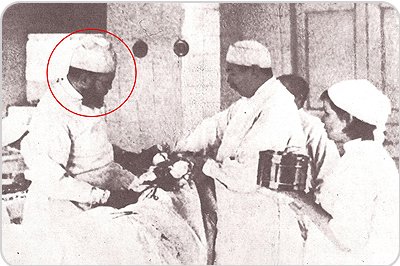
In Pereslav Zalesky, he performed 650 – 1000 operations a year while on his own. He was one of the first doctors in Russia who dared to perform difficult surgeries on the kidneys, stomach, gallbladder, even the heart or the brain with great success.
Towards the end of his stay in Pereslav Zalesky, he thought of giving attention to the surgery of purulent infections, for the which very few things were taught in university. And then something strange happened. He describes: "I put together the draft of the book, I wrote the prologue, and then suddenly, the following strange thought came to my mind. When this book is completed, the name of a bishop will be on it."
1917 was a very difficult year, not only for himself, but also for Russia. The country was in turmoil. The Tsarist system fell. Multiple temporary governments followed, political destabilization and the October Revolution. At that time, St. Luke's wife contracted tuberculosis. So, they were forced to leave Pereslav Zalesky and move to Tashkent.
They settled into a spacious house and St. Luke was immediately assigned as the director of the surgical department of the state hospital which he diligently organized.
Nevertheless, the political situation worsened. Right after the October Revolution, civil war broke out, lasting for four years and disrupting the vast country.
Millions of people died; many say 20 million and, of course, many more were injured. There were however, other unfortunate victims: children, deprived of their parents, trying to survive by eating garbage. St. Luke went to the hospital day and night risking his life. The few hours that he had back at home, he had to take care of his sick wife and see his children, cook, clean and wash.
In 1918, he became the leader for the Foundation of the University of Tashkent and was voted professor of topographic anatomy and surgery.
The political situation was uncontrollable. Civil war rampaged everywhere. The Tsar's family was held under confinement, in Yekaterinburg. In July 1918, the royal family was executed without a trial.
This murder heightened passions and savagery. People were in despair. For the slightest thing, you could be arrested. A small lie was enough. Something similar happened to St. Luke. Because he told off a problematic and drunkard worker of the hospital, the man slandered him to the authorities. One morning, while he was entering the operating room, they arrested him and lead him to Tashkent's railway station. They had then arrested 2000 soldier rebels. They brought them to trial briefly, condemned them to death and executed them on the spot. St. Luke queued and waited for his execution. The hours seemed endless. Late at night, after 16 hours of waiting, a partisan recognized him. He learned how he had been "framed" and intervened. They set him free. And here his heart's grandeur and his self-denial are evident. Instead of returning home, he went back to the hospital. Like nothing had happened, he entered the operating room at midnight and begun to operate.
However, this dreadful event aggravated his wife Anna's already deteriorating health. A few days later she died in the saint's arms. She was only 38 years old and St. Luke was 43. They buried her in Tashkent's cemetery. He wrote on her grave: "Anna Vasilevna, 38 years old. A pure heart, which passionately sought truth."
St. Luke had been left a widow with four small children. Right at this very difficult moment God provided the solution. A very faithful nurse, who had been left a widow, took up raising his children and became their second mother."
At this point we should say a few words on his medical and surgical skills. Today, in Russia, he is considered the top surgeon of the twentieth century. As the academic professor Kasisrky writes, "...his name and skills had become a legend. He could perform the most difficult operations without any problems." He himself would say, "A surgeon must have the eyes of an eagle, the heart of a lion and the hands of woman," (that is, have a fine sense of touch). Once, he took a stack of twenty sheets of thin paper and a lancet. He told his children to tell him how many sheets to cut through in only one movement. His children told him seven, and in one go he cut through seven sheets, astonishing everyone.
Apart from his scientific training, he was distinguished for his deep faith in God. Inside the operating room he would ask God for help. On the wall he had hung an icon of Christ and the Virgin Mary and in front placed an oil lamp. He would light it, pray for a few minutes and after that he would make a cross on the patient's body, using the gauzes and iodine, where the operation was to take place. Only then would he proceed with the surgery.
Even though St. Luke was always close to the church, during that period he took part more actively in Tashkent's church life. This gave the faithful particular joy. One day, in the cathedral church, there was place a clergy-laity tribunal, with the aim of prosecuting the Archbishop of Tashkent, Innocent. Valentin, then a doctor, was also called to the hearing, and he vigorously defended the archbishop. Archbishop Innocent was acquitted and particularly moved by the doctor's stance. When the session was over, the archbishop waited for the doctor at the door. They walked around the church two or three times, while the archbishop thanked him for his defense. Suddenly the archbishop stopped, looked the doctor in the eyes and said, "Doctor, you must become a priest." The saint, with no hesitation replied, "Your Eminence, if it is God's will that I should be a priest, then I will."
Indeed, in January 1921, he was ordained a deacon and then a priest. This occasion of the ordination of a famous university professor, was to be like a bolt of lightning for Tashkent. The saint took up daily duties and preached God's word on every occasion. He also confronted the mockery of his colleagues and students who thought that he was now "finished with science." However, he contradicted them.
Let's digress to look at the political situation dominating the Soviet Union. The civil war ended in 1921. The winners gave themselves to a merciless persecution of all the people they believed to be suspects, counterrevolutionists, etc. The prisons were filled up and the revolutionary courts were working nonstop. An unexpected event would worsen the situation. Lenin got sick. In a period of two years he succumbed to multiple strokes that would finally confine him to a wheelchair. Then the battle for succession started. Despite predictions, Stalin prevailed – a ruthless man, who not only drove millions of citizens to their death, but even his comrades and friends.
During 1920s, "reformatory" military camps for were founded, that is, forced labour camps under the name "Gulag." Within a few years gulags spread across the huge country. They started from Solovki Monastery. It was built during the fourteenth century on the Solovki Islands in the White Sea. It was a large monastic center, with the central monastery and many sketes on all the islands. The winter cold is harsh there, lasting 8-9 months. Because it's impossible for anyone to escape, Solovki became the perfect place for a military prison.
The detainees worked sixteen hours a day and if they underperformed, they were executed as saboteurs. If they wished to punish someone, he was sent to Sekirnaya Skete, which was on a hill. There, they took their clothes and tortured them naked in the snow and ice. As food, they only gave them daily a soup made of rotten potatoes. After a few months, when the detainees were exhausted, they took them to the edge of the hill, where wooden steps had been set up with 365 steps. They tied them up with ropes like small barrels and threw them off the iced steps. The detainees found tragic death. There were so many dead that a tree formed the sign of the cross with its branches.
All the other camps started from Solovki. The detained worked as slaves, and countless died from torture, sicknesses and hardship.
At the same time a merciless war started against the Church. Using various legislations, the Church was chained up. Many churches and artistic monuments were closed down, blown up, transformed into gymnasiums, military camps and entertainment centers. The holy icons were burned. Numerous churches were plundered, while saints' holy relics were desecrated.
Three hours from St. Petersburg, close to the Svir River, is the Monastery of St. Alexander of Svir. St Alexander was a great figure, he was granted to see the Holy Trinity and after his death, his relics remained incorrupt.
In 1918, the revolutionaries entered the monastery and executed all the monks. After that, they took St Alexander's relic and threw it in fire. However, the relic did not get burned. They then transferred it to a museum for mummies in St. Petersburg. In 1997, the monastery reopened and the fathers asked for the holy relic back, but the museum's administrative body would not give it back as they considered it a mummy. Upon the fathers' insistence, the museum's administrative body brought in an X-ray machine and performed a radiography on the saint's body and realized that it was not embalmed, but incorrupt. In this way, they were forced to return it to the fathers and the saint returned to his home.
The people demonstrated their heroic spirit on many occasions defending the churches. I will only bring up one touching case. In the city of Olonets, in 1927, they tried to destroy a church. A young girl, about 25 years old at the time, was informed of it. She ran to the church, entered and locked herself in and yelled at the workers, "Demolish the church and kill me with it."
The workers waited for her to come out, since they didn't want to kill her. Finally, after a few days they left. And this girl remained the guard of the church for 25 years. She cleaned it and took care of it, while the people brought her food. The church was saved. At the end of her life she became a nun and took the name Varvara. She "fell asleep" at the age of 96 and was buried next to the church. They all honor her as a saint.
Among the victims were clerics and monks. Throughout
Russia, only in the year 1922, 8100 clerics and monks were
executed. In St. Petersburg, on the wall you see, over 40
fathers of St. Alexander Nevsky monastery were
executed.
On one Sunday, again in St. Petersburg, they arrested 40
priests while they were performing the liturgy. They took
them to Smolensk cemetery close to Saint Xeni's grave.
They provided them with the tools to dig a big hole. After
that they threw them in and buried them alive. In this
way, the blood of many neomartyrs spilt, and today the
Russian Church can boast for her countless new holy
martyrs.
Lets return to Tashkent. At this difficult time, St. Luke chose to be ordained a priest. However, new responsibilities awaited him. Archbishop Innocent was exiled in 1923 and the people proposed that Father Valentin take his place. He humbly accepted God's new calling, knowing all too well the dangers. At that time, there was an exiled bishop in Tashkent, who initially tonsured him a monk. As there was no church, his tonsure took place in his children's bedroom. It was there he gave his monastic vows and Valentin was named Luke. Because the bishop was not able to ordain him a bishop on his own, he suggested he go to Penjikent, where two exiled bishops remained. He left during the night, cutting through Uzbekistan with the travel means available at that time, confronting many dangers. His first stop was Samarkand. From then on, things were even more dangerous because of rebel combatants. With a much of difficulty he continued for Tajikistan. In the city of Penjikent he found the two bishops who ordained him an archpriest in complete secrecy, during the night. The date was May 31, 1923. Afterwards he returned to Tashkent.
His anointment brought about new disturbances in Tashkent. The partisans started to slander him and undermine him through the press. It was a short while after, on Saturday June 9, 1923 when he was arrested and led to Tashkent's prison. This is how eleven years of imprisonment and exile began. He remained imprisoned for two months and then he was sent to Moscow, where he visited the martyr Patriarch Tikhon twice, who was placed under confinement in Donskoy Monastery. Patriarch Tikhon encouraged him not to stop his medical and surgical activities because in this way he could help people. Patriarch Tikhon, after bearing the great burden of persecution, "fell asleep" on May 25, 1925. His words were very prophetic: "The night will be very long and very dark." He has recently been classified among the saints.
A week later St. Luke was taken to terrible Lubianca, the building of CK-KGB. In this building he was interrogated with the interrogators' harsh methods, with a spotlight in his face. Millions of people were interrogated and condemned in this building, while many were lead underground where they were executed with a bullet through the neck.
After his interrogations and his condemnation they put him in the awful "Black Crow," the CK's police van. The "Black Crow" was a Russian's worst nightmare. It transported the arrested and was always full. Many of the detainees suffocated. St. Luke was taken to Moscow's worst prison, Butyrka. The chambers were overfilled. Most of the detainees slept on frozen floors. The blinds on the windows were shut. An electrical lamp was constantly on and the detainees never knew whether it was night or day. Sleep was a real torture. They did not fit on the floor and to turn over they had to work together. There could have been 30-40 people in a chamber for six. In those prisons, the saint became aware of his first symptoms of heart failure, which would worsen during his exile and accompany him for the rest of his life.
Two months later they transferred him together with two other detainees to the prison of Taganka, on foot. One day they gave him a fur coat from the Red Cross as a present. He didn't keep it for too long. He gave it away to a young detainee that was shivering from the cold.
In December of 1923 and during the harsh cold, despite the fact that he was sick, he was sent into exile to Siberia. The train trip lasted a month. For food each day, they gave them half a herring, a piece of bread and a glass of water. The train compartments did not differ from prison cells. They were also full of prisoners and each stole from the other.
A month later, they reached the town of Krasnoyarsk in the heart of Siberia. Later he was exiled to the city of Yeniseisk, 430 kilometers northwards. The trip took place inside a ship's dark hull; today, it's a museum. In midwinter, he reached Yeniseisk. Its quarters were more humane. A room in the house of a wealthy inhabitant. With him were two other priests. The house was converted into a chapel and a clinic where he examined patients.
A little later he asked to be employed at the hospital of Yeniseisk. The doctors were surprised but also happy to have a famous surgeon with them. They gave him permission, so he started operating. The needs there were also many. Waiting lists extended up to two months. In 1924 he attempted to perform an innovative and extremely difficult operation. A man with a serious kidney failure was brought in, and St. Luke attempted and succeeded in doing the world's first animal to human kidney transplant.
As a reward, the local authorities sent him far away to a forgotten village, Hayia, which barely had eight homes and was stranded by snow. Despite all the difficulties there and very little equipment he possessed, he did not seize to operate. Among other operations, he operated on a patient suffering from cataracts with great success. We should note that he would sterilize his equipment in a samovar.
In the summer, he was taken back to Yeniseisk. The saint was "hosted" in the prison's isolation ward that was full of bugs and would not let him rest. Afterwards, they set him free and he was able to perform operations and serve the liturgy in an old monastery of Yeniseisk.
He operated endlessly. The inhabitants loved him exceedingly. Nonetheless, as love for him grew, so did the authorities' hate for him. So they decided to send him to the freezing north. In the port of Yeniseisk, they loaded him onto a barge and via the River Yenisei, he traveled approximately 2000 km (about 1240 miles) further north. The trip was endless, monotonous, boring, tiresome and tormenting. The food was minimal, or rather, the prisoners had become food for lice.
At some point they reached the city of Turukhansk. Here, climate conditions render life unbearable. The winter is dark and never ending. Everything is frozen. In the small summer season swarms of mosquitoes make the inhabitants' life torture. St. Luke worked at the small hospital. There was no other doctor, nor was there the right equipment. The only thing he found was a bottle of alcohol and a small pocket knife. He operated using them and tied the wounds with the patients' hair.
On the Yenisei's banks there was also a small monastery, with a relic of Saint Vasilios Magaseisk. Saint Luke would perform the liturgy there. In his face people found the real shepherd and doctor of souls and bodies. But again, the people's love bothered the local authorites. He was invited to give an explanation for his operations, liturgies and preaching. One night, they notified him to get ready and leave quickly for the North.
At this point we will again open a parenthesis. At that time, millions of prisoners were taken to the tundra, the frozen north. There, snow doesn't melt away completely, not even in the summer, which lasts for two to three weeks. The prisoners had to build new towns, factories, streets, railways from nothing in the middle of nowhere. Temperatures there can reach -60°C (-76°F) and when it's windy the situation is unbearable. Detainees died in heaps. The area is sown with the bodies of prisoners. To this day, when the snow melts and water flows from the mountains where there had been mines, human bones come out from the earth. The dead were innumerable, nobody can calculate the number. In the city of Norilsk, built by prisoners in the 1930s, they have erected "the Golgotha of Norilsk," with many crosses and monuments of different nationalities, a reminder of the torments of these people. And in the surrounding cities, a few small museums take us back to that tragic era.
St. Luke almost followed this same path. The trip of over 400 km (250 miles) had to be done in a sleigh. It was a painful trip, in the heart of winter. The cold was terrible. Darkness awful. The first stop was Selivanikha, a small village. He continued the trip over the Yenisei River. Having passed the northern polar circle, they reached the village of Plahin, consisting of 15 people. He was given a room in a wooden small house. There was ice all around. So tremendous is the cold there that birds are unable to live. The small wooden stove was not inadequate. The water in the bucket froze. When it was windy the situation was desperate. He remained in Plahin for about two and a half months. Only God's grace kept him alive.
In March, the director of the CK sent another sleigh to bring him back. In Turukhansk, a patient died helpless. The people revolted and demanded that their bishop and doctor return. This is how he again found himself in Turukhansk, and undisturbed, continued his work in the hospital and the monastery.
His sentence was nearing its end. He waited in agony. He saw riverboats leaving with the prisoners but he was not called. At the end of August, boat lines seized because the river froze and so he need to wait for the next summer. Finally, he was freed in November 1925. Now he would be forced to travel by means of a sleigh over the frozen Yenisei. The trip was difficult and dangerous. Altogether, they traveled approximately 2000 kilometers (1240 miles). He reached Krasnoyarsk and from there traveled by train to Tashkent.
He again took up his archbishop's duties. He was not given a position in the university so he received patients at home. Many young adults gathered around him, whom he helped as a father and they helped him at his work. They would run around finding poor patients and notify him. The people loved him very much.
Not much time passed when new problems arose. A mentally ill patient and professor committed suicide. His suicide was characterized as murder and they started accusing the Saint as an accomplice. For a whole year they slandered him through the newspapers. They even wrote theatrical plays about the bishop murderer. Finally, in 1930, he was arrested. Again, he was imprisoned in Tashkent, again cruel interrogations, threats, blackmail. Everyone defended his innocence in vain. He remained in the prisons of Tashkent for a whole year and then condemned into exile in Northern Russia. They took him to the railway station. They behaved inhumanely. Someone who was present at the time recounts: "we gathered many people.. We saw him from afar. They dragged him by his beard, as if he were a bum. They spat in his face. At that moment, I suddenly thought how Jesus Christ was scoffed at the same way."
He himself writes about the train trip: "The wagon was so full of lice that I had to take off my clothes morning and night, and daily I found hundreds of them. Among them were also some huge black lice that I had never seen before."
Days later they reached the city of Kotlas. It was also built by prisoners inside endless forests and many of them died in martyrdom. St. Luke was initially brought to the prisons of Kotlas and after that was taken three kilometers further to Makariha. They lived in miserable makeshift shacks. Many of the prisoners were sent off to the woods to cut trees and make shacks. They were forced to sleep on the terrain facing cold weather and humidity. Many committed suicide. In Makariha at the time, a typhoid epidemic and other sicknesses broke out. The detainees died helpless. Everyday they dug a huge pit in Makariha and buried around 70 dead. Today in Makariha many monuments are placed reminding about the tragedy of those people.
St. Luke witnessed this drama, the carnage of the dead, without being able to offer anything. A little later, they transported him to Kotlas' hospital and allowed him to operate because the needs were so great. It was not long when he was again transferred. On a riverboat on the Dvina River, he was taken to Arkhangelsk. It is one of Russia's most northern cities. They had sent thousands of prisoners at the time so he had a very difficult time finding a house. The exiled shivered in the streets, there were not enough houses. He finally found a room in a big house where other exiles were staying. The authorities allowed him to operate in the hospital but he faced jealousy from his colleagues. He went to church in the church cemetery, but even there they looked at him suspiciously.
In 1932, a tumor appeared so he went to St. Petersburg, where he was operated by an oncologist. Fortunately, the tumor was benign. In St. Petersburg he was invited to see Kirov, a high ranking executive partisan. He proposed that they give him the greatest surgical centre of the country, the only term being, to throw away his religious vestment and deny Christ. He did not accept and returned to the place of his exile.
In 1933, his famous book was published Treatise on the Surgery of Purulent Infections and was signed Bishop Luke. This book was accepted enthusiastically and has been repeatedly published. Professor Polianoff stated: "There is no other book in our country with so much knowledge on surgery and so much love for the human being."
From 1933 to 1937 he remained in Tashkent. He lived quiet family moments with his children, which he had been deprived of for so long. He worked mainly in the scientific research field, which really pleased him. He needed to learn every detail about pus. He wrote to his son: "I am making extraordinary discoveries. I am working endlessly. I want to write a lot of things. I fear that I won't have the time. I am at the culminate point of my age. I need to get the time...".
He was one step away from discovering penicillin. He did not do so in time.
The thirties were the age of Stalin's omnipotence. The Gulag Archipelago was at its peak. Millions of people were sent to concentration camps and worked in forced labor. In Belomor canal more than 300,000 people worked to open up a 280 kilometer canal, digging with primitive means in granite. At least 100,000 died while others were maimed. In 1936, terrorism had reached its peak. In Moscow the famous Moscow trials were taking place, where the leaders of the revolution were exterminated. Arrests of innocent people had taken the form of an epidemic. And, of course, Bishop Luke was assumed a suspect.
A night, in 1937, commissioners entered his house and arrested him. Outside awaited the "Black Crow" to take him to Tashkent's prisons. The charges were that as a doctor he was killing patients, that he was preparing a counterrevolution and a plan to murder Stalin. Many of his collaborators were also arrested, who succumbed to torture and testified against him. Himself, so as to be forced to sign, was put to the cruel, torturous chained interrogation. Set on a chair under a strong spotlight, he was interrogated night and day, by different interrogators for thirteen days and nights.
They wouldn't let him eat or sleep. He often fainted, and they would throw at him cold buckets of water to bring him back to his senses. Because he did not sign the accusation, he was sentenced for another thirteen days and nights to chain interrogation. His body was filled with wounds from the blows. They left him for two years in the Tashkent prisons in continuous threats and torture.
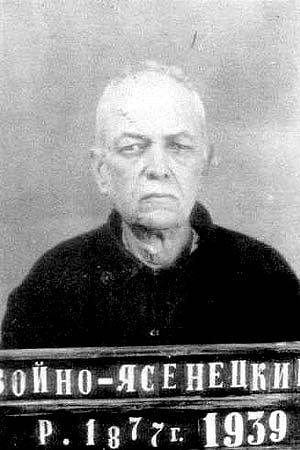
There was no church inside the village. St Luke went every morning to a small nearby forest to pray. He placed an icon on a log, kneeled in the mud or on ice and prayed. But even this place was defiled by young atheist komsomols. God was exiled from everywhere.
Today, people still living in Great Murta remember him with much love. There still isn't a church in the town. The people, though, have started its construction and it will be dedicated to St Luke. In fact, the day the cornerstone was added, a woman was miraculously healed by the saint. There, they placed the cross, a reminder of the saints miraculous intervention, while in front, they have left the rock on which the sick woman was seated. On that day, the world scenery was reigned by war. Hordes of Germans entered Russia and caused huge disasters and countless victims. The whole country was placed under trial.
In Krasnoyarsk the trains arrived full of wounded soldiers, in complete purulent traumas. Many of them died helpless. The doctors were very few. St Luke, touched by this sad situation, sent a letter to the president of the high Soviet Kalinin and asked that he be allowed to operate on the soldiers. The answer came immediately. Soon enough, he was transferred to Krasnoyarsk, hired as the head doctor of the military hospital 1515 and advisor of all military hospitals of the area.
There too he faced his colleagues' suspicions, constant monitoring by the KGB. His residence was a narrow, humid room in the hospital. He also faced contempt from superiors. They considered him a secondary class citizen and forbade him to eat in the military hospital's restaurant. On many days he remained unfed. Some nurses, who felt sorry for him, secretly brought him some food. They never heard him complain. He endured everything with great faith in God. In one of his letters to his son he wrote, "I loved martyrdom, which so strangely cleanses the soul."
Every now and then he went to the train station and choose the most heavily wounded to operate on. All the soldiers, loved him extensively, because they felt he had saved their lives. The intensive work had also affected his health. Fatigue overtook him. Still, he always thought about those suffering and served them in incredible self-denial.
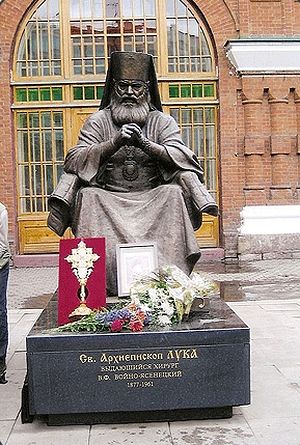
Today, in Krasnoyarsk a church is being built in honor of Saint Luke within the general hospital. Contemporary doctors are thankful to him and feel benefited from the tradition he passed on. A big statue of the saint has been placed on a central spot of the city. Passers by will always stop, say a couple of words as a prayer and leave him some flowers.
In 1944, they transferred him to Tabof as a head doctor and archbishop. There too, everything had been destroyed. With much effort, he rebuilt the ruined church of Holy Protection and started liturgies and preaching with a lot of joy, because as he said in his first homily, "For fifteen years my mouth was closed." At the same time he worked at the city's two hospitals, the general and military, while he lectured in the Medical School and in medical conferences.
Within the ecclesiastical sphere, he committed great effort to reorganize his province. He preached God's word in the churches. People ran to hear him speak and were deeply affected.
Authorities were alarmed. They recognized his enormous scientific, social and patriotic contribution, but they could not accept his preaching and pastoral contribution. Often he was invited to scientific conferences or to the university, with the requirement not to walk in his religious cassock and bishop's pendant. He did not give in to these demands, and it seems he was no longer afraid. Within two years, Tabof's people grew to extremely love him. And here, the traces he left endure.
Today, the city's general hospital bares his name. His bust has been placed in the front courtyard, while close by, in the Medical History museum, a large section is dedicated to St. Luke.
Despite his great work load, he took part in the Moscow Patriarchate's Councils. In 1946, he was finally recognized. Some partisans slandered the saint to Stalin and demanded his execution. Stalin angrily swore at them vulgarly and concluded: "We cannot execute those people any longer, but we need to honor them." And indeed, St. Luke was honored with the state's greatest public award, the 1st Stalin award out of fifteen scientists. The ceremony took place in Moscow. Everyone was present. The only one missing was St. Luke, as he could not afford the train ticket. The prize was accompanied by 200,000 rubles. He then sent a telegraph to Stalin, asking that this money be given to the war orphans.
That same year, by order of Stalin, they constructed the saint's bust, that up to this day exists in the Klenofsky Museum in Moscow, among other great scientists' busts. Many foreign journalists arrived to interview him and special broadcasts were made. But his health was deteriorating and in 1946 he lost his sight in one eye. The Church transfered him to the Archdiocese of Simferopol and Crimea.
Crimea is a beautiful area, with intense Greek colors, but also hardship. The catastrophes left by the war were numerous there too, the Church ruined. And St. Luke fought a titanic battle to revive it. In this effort he faced the reactions of the local authorities, who continuously created difficulties and undermined him. The poor were many so he organized administering food rations in his house. Many times he remained unfed, so as not to deprive the poor from food. There too, he was invited to conferences and to teach lessons in the Medical School. At times, authorities demanded that he did not show up in his cassock. He refused, hence some conferences were cancelled.
His daily life was full. He woke up very early and did his prayers for 2-3 hours. After that he read an excerpt from the Old and New Testament. Following that, he went to his office and occupied himself with the matters of the Archdiocese. In the afternoon he would always accept patients free of charge.
Different people would come to his medical office: atheists, those of different religions and of different nationalities. He offered his help without discriminating.
In 1956, he lost his sight from his other eye as well. Despite being blind now, he continued to work tirelessly, to preach and serve the liturgy. In 1957, in Simferopol, they celebrated his 80th birthday.
And when Stalin died in 1953, Chruchstschow attempted de-Stalinization. Most of the prisoners were freed and military camps closed. This positive development is overshadowed by a new war against the Church. Chruchstschow reopens the counter-church front. Churches are seized, closed and blown up. Priests are persecuted. St. Luke faced many problems and fought to keep the churches open. Agonizing through letters he writes to his children:
"It keeps getting harder for someone to manage church affairs. It's a martyrdom. I cannot bear it at my age of 80. But with the Lord's help I will continue my difficult work."
The authorities seek his exemplary punishment because he refused to close the churches. But they did not dare jail or exile him.
In another letter to his son, he wrote:
"I am much more deeply sorrowful than you are for
their hastening my end...In general the situation in the
church is becoming unbearable."
The archbishop's earthly life approached its end. On Christmas 1960, he performed the liturgy for the last time, while on Lent Sunday he gave his last homily. From then on he stayed at home. He prepared himself for the great voyage by prayer. A little before his "falling asleep" he baptized his great granddaughter Tatiana, today a doctor in Odessa.
One day he said to his niece, "I wonder, will they allow you to sing the 'Trisagion" at my funeral?" His niece did not understand what he told her. She understood at his funeral.
Sunday of All Saints of Russia came on June 11, 1961. It was a quarter to seven in the morning when Saint Luke took his last breath and his soul flew to heaven. He left so that he could have the time to perform the divine liturgy at the heavenly altar. The sad fact was spread as fast as lightning. For three days, thousands of people came to venerate his relics. In front of his casket they broke out into burning tears and shouted: "Our father has left, our saint" and told about his benefactions and miracles.
All those people wanted to have a grandiose funeral and to carry his relics in Simferopol's central avenue. But on the day of the funeral, an urgent telegraph came from Moscow that forbid carrying the dead in the central streets.
The ones that wanted to take part, had to take free buses free which travelled on outlying roads all the way to the cemetery. No chanting was allowed. Within three minutes everything had to be concluded and the deceased had to be already in the grave.
The ceremony was watched by many police officers to make sure this order was observed. But right after the funeral procession the people revolted. Fights and conflicts with the police followed. At some point the road cleared and the vehicle carrying the casket tried to leave. A few women broke through, grabbed ahold of the car, while three heroines fell in front of the vehicle's wheels and got it to stop, screaming: "Only over our dead bodies will you go where you want."
At that point, a big flock of pigeons appeared in the sky, circled over and followed the procession. In the end the policemen retreated. The procession went into the main avenue that was filled with a crowd and there were roses covering the ground for approximately two kilometers. All the people sang the "Trisagion" with one voice for three and a half hours.
He was buried in the All Saints cemetery, and from then on, his grave became the Pool of Siloam. His miracles are countless. And so, in 1996 the Russian Church went on to place him in the official list of saints. In March of 1996, the Archbishop of Crimea Lazarus and his priests recovered his relics. During the recovery, a sweet aroma spread across the area. In his relics, his heart, his brain his eyes and lungs were found incorrupt.
On the March 20, 1996 his relics, together with the participation of thousands of people were taken to the Church of the Holy Trinity in Simferopol. In 2001, they was placed inside a beautiful silver reliquary, donated by Greece.
In 1997, in front of the hospital of Simferopol, his statue was placed by Archbishop Lazarus, while in 2005 his bust was placed at the Medical School, where the church of St. Luke is being built.
He is commemorated on the June 11. Every year thousands of people come to the celebration from all parts of Ukraine, Russia and abroad.
In the morning on the feast's eve, the Medical School with the dean leading them, sing the Akathist Hymn to the Saint and place their medical shirts in front of the reliquary to bless them.
On the day of the Saint's commemoration they perform the Divine Liturgy and a procession of his holy relic.
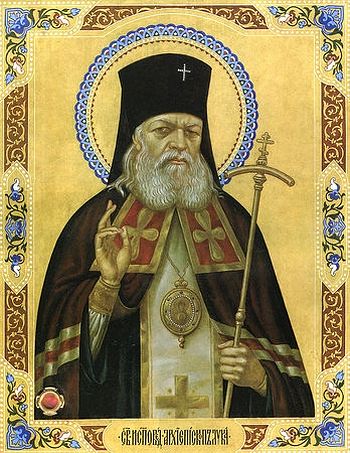
His miracles are countless. Not only in Crimea, but in Greece as well. His appearances and interventions are many. He has appeared to many people in their sleep wearing his hierarchical vestments and medical uniform. He holds surgical tools in his hands, gauzes, syringes, etc. And after he presents himself to the patients, he tells them that he has come to operate on them. Many find an incision or blood on their bodies when they wake up in the morning.
Really, what was it that glorified Saint Luke and gave him so much grace? He had many virtues. But I believe that what distinguished him the most was love, the crown of virtues. Love towards God and fellowman. A genuine offering of love, sacrifice, self-denial.
In the land of Palestine there are two lakes and a river. The first is a small lake, that of Tiberia. Even though its a small lake, it's alive, has many fish and there Christ's apostles fished. The second lake found in the South is the Dead Sea and is four times bigger than the first. But it is dead. It has no trace of life. The two lakes are joined through the Jordan river. It starts from Tiberia and goes on to the Dead Sea. And this is the paradox. For centuries now, Tiberia offers its waters, gives and remains constantly alive. And it does become empty. For centuries now the Dead Sea endlessly receives those waters, but it does not liven up. It takes the waters and remains dead. This is the nature of love. We don't ask for love, we don't demand it from others. We only offer it, without retaining, without calculating and only then we are alive. The person who from a young age has learned to take and not to offer, is disabled, dead, unhappy. The person who learned to love, to sacrifice, to offer and be offered is alive and happy.
This was St Luke – a man of love, offering, sacrifice, self-denial. That is why he received so much grace from God and continues to live, to perform miracles, to be so close and console us.
May his life inspire us and may we have his blessing.

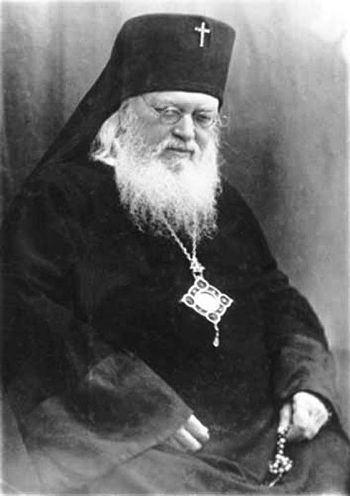
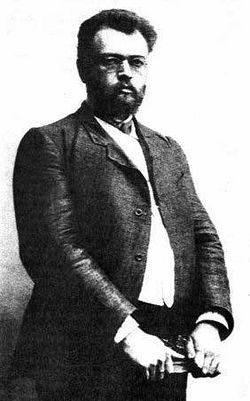
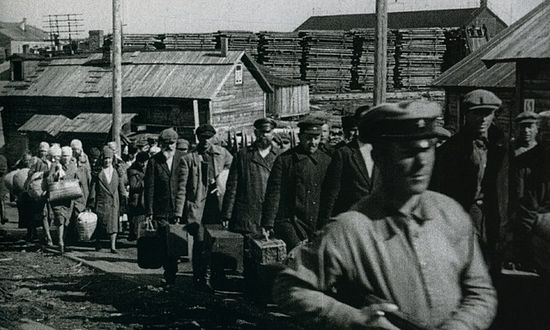
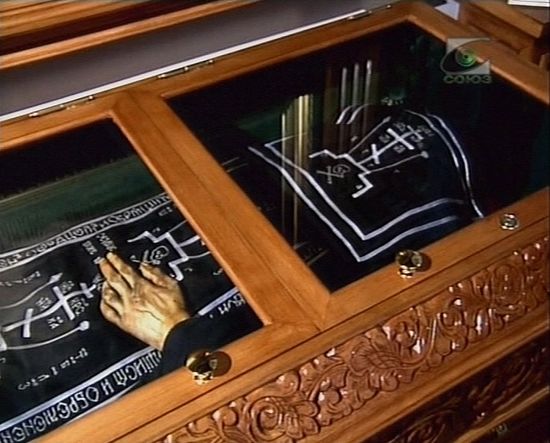
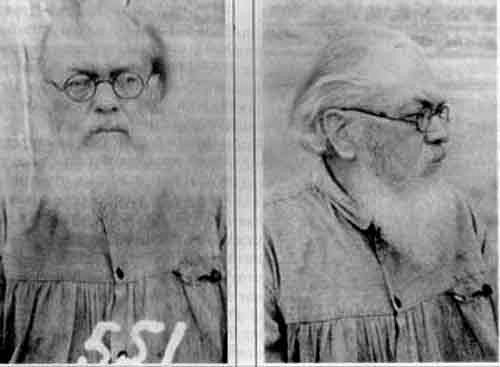
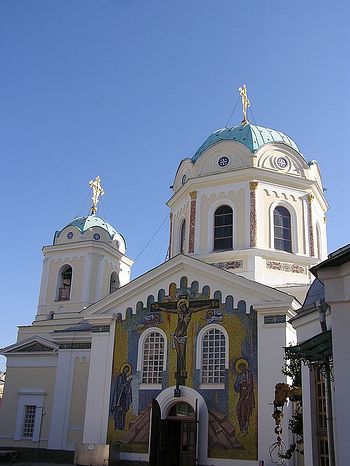
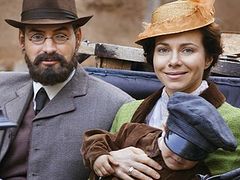
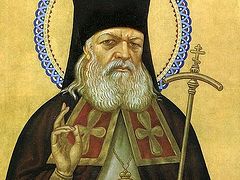
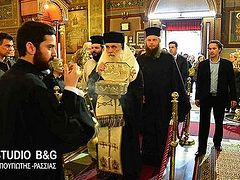
holly prayers.